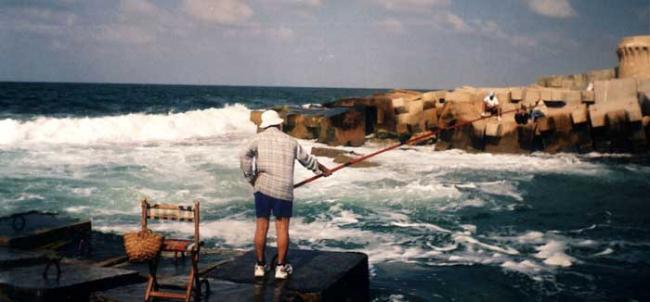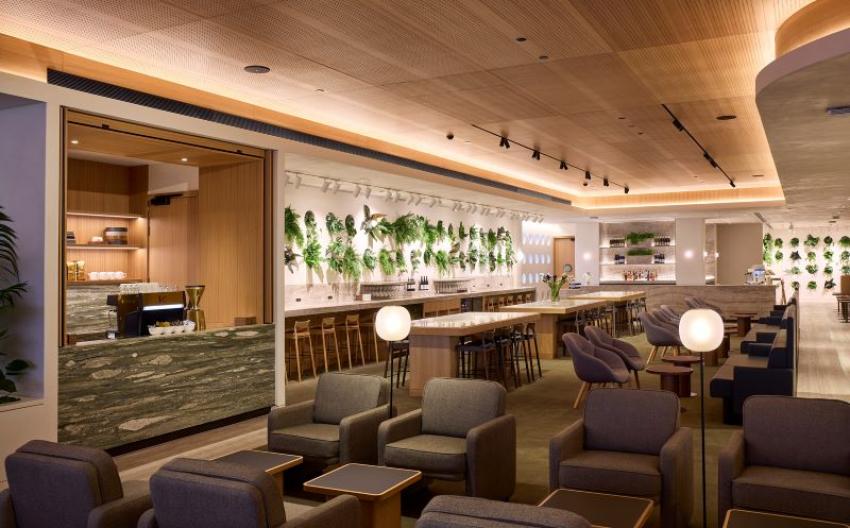The lady at Cairo's central railway station tourist office was helpful. "Run, or else you would miss the train," she told me. Right she was and I ran for the ticket counter just about managing to pick up a brochure onAlexandria. The man at the ticket counter saw me in the queue and yelled, "Run and board the train first and get the ticket on board, else you miss this one." So I ran like crazy and just about managed to catch the train. I intended to board second class and save some money but I ended up in a first class coach in a hurry by mistake and paid a little more, all along under the impression that it was a second class one and wondering how good Egypt's second class train travel is. No regrets, for it costs only Egyptian pound 30 (one USD is about six Egyptian pound) which is not much anyway. I swear from the experience of my return journey that the second class travel (AC) is no less comfortable. Warm, helpful Egyptians make any journeys comfortable in that magical country.
I was relieved immensely to be on board. I was there at last making a two-and-half hour journey to the city of my childhood dream. I was watching the Collin Farrell movie on Alexander recently and felt proud to have visited the pearl of a city on the Mediterranean named after the Greek hero. Alexandria is a dream come true for me.
As I settled down in the comfort of the train and the cluster of slums and apartment buildings of Cairo gave way to a more sylvan scenery, I explored the brochure, its cover featuring a majestic fort (called Qaitbey Fort as I later discovered). Later in the day as I spent hours with an Arab speaking cabbie who does not understand an iota of English, I only knew how blessed I was to have picked up the pictorial brochure. It was sign language, randomly picked up interpreter on the streets and essentially the pictures of the famous places on the brochure that came to my rescue in Alexandria. I come to description later, but Alexandria for me is my first brush with the lush, lashing blue Mediterranean. It is a feeling which one has to experience to share. I was so overcome with the beauty that the liberal sprinklings of a huge wave soaked some of the pages of my passport which was in my shirt pocket.
Called the Pearl of the Mediterranean, Alexandria is the second largest city in Egypt. Alexandria has an atmosphere that is more Mediterranean than Middle Eastern; its ambience and cultural heritage distance it from the rest of the country although it is only 225 km from Cairo. Named after Alexander the Great who ordered its foundation in 331 B.C., on the site of a small village called Rhakotis, it became the capital of Graeco Roman Egypt and became a Greek cultural hub. Since its foundationAlexandria remained for many centuries a centre of cultural radiation in the whole world and status as a beacon of culture is symbolized by "Pharos," the legendary lighthouse that was one of the Seven Wonders of the World. The setting for the stormy relationship between Cleopatra and Marc Anthony. Alexandria was also the centre of knowledge in the ancient world. But ancient Alexandria declined. Since the 19th century,Alexandria has played a new role, as a focus for Egypt's commercial and maritime expansion. This Alexandria has been immortalised by writers such as E.M. Forster. Generations of immigrants from Greece, Italy and the Levant settled here and made the city synonymous with commerce, cosmopolitanism and bohemian culture.
Today, traces of the past evokes a sense of deja vu. Visitors can eat seafood caught by local fishermen, take a tram (reminded me of my native Kolkata) to view Roman ruins or drink coffee in European –style coffee shops and cafes. A waterfront city, Alex (as it is popularly known) runs along the Mediterranean for 20 km. Getting off from the train, I hired a cab whose driver could speak only Arabic and not a single word of English. The pictorial brochure was my saviour. I first headed for the Pompey's Pillar which dates from the third century. It is a 25 metre high red granite column, constructed in honour of the Emperor Diocletian, originally from the Temple of Serapis. It was once a magnificent structure rivalling the Soma and the Caesareum. Two pink granite sphinxes are the other remnants of the site. Nearby are subterranean galleries, where the sacred Apis bulls were buried. Next on my agenda was the Catacombs of Kom El-Shoqafa. We have all read about catacombs (underground gallery of burials) in the history books and so it was thrilling to actually see one. Photography is not allowed here in the eerie underground. As I climbed down the spiral stairs round a well to usher into the claustophobic catacombs, I felt awe-struck. This warren of tombs, on three levels, also houses the Triclinium, where relatives used to sit on stone benches to feast the dead, and a central tomb with relief work of bearded serpents. Inside, there are 2nd century statues of Sobek and Anubis wearing Roman armour. It is a blend of Pharaonic and Roman art.
Alexandria as I learnt is a year-round resort. In winter, the sun still shines along the white sand coast while yachts race in the harbour. In summer, sun lovers seek out the cooling sea breezes. Whether you come for the past or the present, for history, or just on holiday, when you visitAlexandria, you'll see more than one city. The city centre stretches from Saad Zaghloul Square, to the sea front, where there is a statue of Saad Pacha. This was formerly the site of the Caesareum, a magnificent temple built by Cleopatra for Marc Anthony and subsequently completed by their enemy Octavius. Two famous obelisks (one known as Cleopatra's Needle, now on the Embankment in London; the other in New York's Central Park) were once here but all traces of the temple have disappeared. Post-colonial architecture like Hotel Cecil vies with more modern buildings. The Unknown Soldier Monument located near Tahrir Square catches the eye of a traveller in this gem of a city. Strolling round here you can still see old street nameplates and find the jewellery and antique shops for which the area was known, as well as modern restaurants and cafes.
If you are on a day's trip to Alexandria then the high point should be to relax on the northern tip of the Eastern Harbour by the Sultan Qaitbey's Fort, an Alexandrian landmark. The fort is on the original site of Pharos,Alexandria's ancient lighthouse (one of the ancient seven wonders of the world), built in 279 B.C. Although Pharos, which was topped with a statue of Poseidon, was restored at various times, it had crumbled in the 15th century AD. Today, the Fort houses a mosque and the Naval Museum. It also provides wonderful views of the city and the Mediterranean. The first submerged antiquities museum has been inaugurated; "Cleopatra Empire" referring to the old city of Alexandriawith its colorful palaces, rich inscriptions, ships and more than 5000 Pharaonic and Roman statues located opposite Qaitbey Fort. A Roman style diving center is located in the Greek Club next to the Fort, which enables visitors to see both Pharos and Cleopatra cities housing her palace, ruins of her solar boat and ruins of an aircraft from World War II.
But above all just sit by the sea here and enjoy an eyeful of blue Mediterranean and the azure sky above. Envy the slow pace of life of some unknown angler there or bless the Egyptian lovebirds swearing by each other with only the Mediterranean as the witness.
It is in Alexandria that you can see the Roman Amphitheatre. Discovered recently in the area of Kom Al-Dekka near the Roman Museum, it consists of 12 rows of semicircular marble seats for up to 800 spectators, galleries and sections of mosaic-flooring. It is considered the only relic of its kind in Egypt. In Ptolemaic times, this area was the Park of Pan, a recreational garden surrounded by Roman villas and baths. Then there are places like Villa Al Toyour, an archaeological residential district in Kom El Dekka dating back to the Ptolemaic era, and includes houses, workshops and a Byzantine school. At Villa Al Toyour, dating to the Roman era 1st Century, see paintings ornamented with birds and portraying a small lamb. Al Anfushi Tombs which lie in front of Ras Al-Teen entrance were discovered in 1901. Dating from about 250 B.C. and painted to simulate alabaster and marble, these limestone tombs are decorated with pictures of Egyptian deities and daily life, besides graffiti that dates back to the same period.
Don't miss the Graeco-Roman Museum in Alexandria. The collection, which covers the period from the 3rd century B.C. to the 7th century A.D, is a fascinating record of a civilization in the process of change as religions merged and society evolved. In Alexandria, Graeco-Roman and Pharaonic religions mingled in the cult of Serapis. The shift from pagan religions to Christianity can also be seen in the exhibits which include mummies, Hellenistic statues, busts of Roman emperors, Tanagra figurines and early Christian antiquities.
Alexandria is also known for its famous library which was later destroyed. A New Library is in place now. The Old Alexandria Library established since 2300 year at Ptolemic era during the reign of "Ptolemos Filadlfos" was a source of knowledge to the Mediterranean region. Now, the Old Alexandria Library has been renewed by establishing the NewAlexandria Library. It is one of the biggest scientific and cultural centers specialised in the region's affairs and its culture, science and arts. It also attracts scientists from the whole world to Alexandria as a world center for culture and knowledge. The dome-shaped structure of the NewAlexandria Library was inaugurated in October 2002 when some of world leaders and heads delegation for 80 countries
A visit to this city is not complete unless you have savoured the chaotic Islamic Alexandria. Al-Gomruk and Al-Anfushi are interesting neighbourhoods to explore, for their souks and streetlife as well as Ottoman mosques and mashrabiya-decorated houses. Here you see El Attareen Mosque, so called due to its location nearby El-Attareen marketplace (Souk), dating back to the 14th century. It is adjacent to an ancient mosque established by Amr Ibn El-Aas, known as the "Thousand – Column Mosque". Othewise, the Mosque of Abu Al-Abbas Al-Mursi, dedicated to the patron saint of Alexandria's fishermen and sailors, is the city's biggest. It has been built in an Andalusian style with four domes and a towering minaret.
Islamic, modern, Graeco-Roman-Alexandria rocks.






